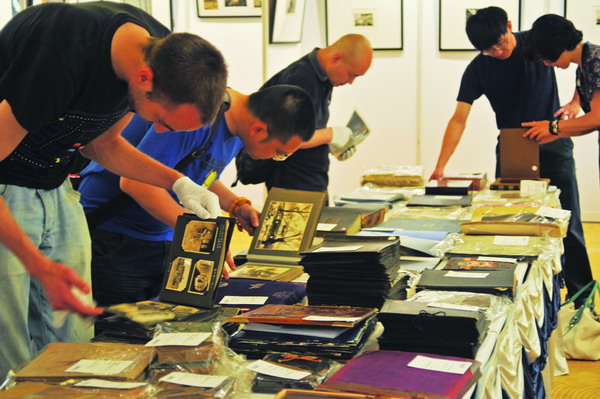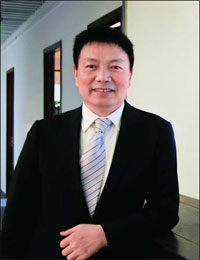Set up for major photo opportunity
Updated: 2013-03-13 16:14
By Sun Yuanqing (China Daily)
|
||||||||
|
 In the West, contemporary photos have been at the forefront of interest, but in China, most collectors are keen on historical pictures. [Photo / China Daily] |
Photography pulls focus in art market as sales of other forms fall
Although considered a major art form in the West, photography has been very much edge-of-frame in China.
But with the sharp downturn in the country's art market, the work of the camera is coming into its own.
"Photographs were the only exception for us in the downturn last year," says Li Xin, the image department manager for Beijing Huachen Auctions, the only Chinese auction house that has photography as an independent category.
And where sourcing artwork to auction is a headache for many companies at the moment, there is no problem finding photographs, as prices keep rising for them, she says.
Huachen generated more than 13 million yuan ($2 million) in photography sales last year, up from 12 million yuan in 2011.
|
 Gan Xuejun is the founder and general manager of Beijing Huachen Auctions. [Photo / China Daily] |
"During the past 10 years, there has been a significant increase in price for photography," says Terry Bennett, a London collector of old Chinese photographs and author of the book series History of Photography in China.
"It is hard to generalize, but today we can expect to pay two or even three times the earlier prices. Rare early material can fetch even higher prices."
There are about 300 collectors of photographic works in China. Xue Manzi, a well-known angel investor, and Zhu Yong, a printing entrepreneur, from Beijing, have been major clients of Huachen, accounting for about half the sales. Both are reported to have invested tens of millions of yuan in photographs.
"Photography in China is still undervalued," says Zhu Yong. "It will take a while to realize its true value, and auction is a better way to do that than through dealers, because it's more transparent."
As a younger art form, photography has yet to see an incursion of speculators and fakes that have bedeviled other sectors of the Chinese art market.
Li says she has not seen anyone dodge payment after winning a bid, which is rare, given the overall rate for defaulting on payment in art auctions in China in 2011 was more than 55 percent.
Founded in 2006, Huachen's image department lost money on its first auction and struggled to make ends meet for the next few years.
"I was always very depressed after the auctions," Li says.
"No matter how hard we worked, we could never compete with the other departments."
With the only two other competitors - Guardian, China's second-largest auction house, and Beijing Cheng Xuan Auctions - dropping their photography sections after the 2008 global financial crisis, Huachen became the only player in the market.
"We thought about giving up, and even canceled one auction in 2009, but we met unexpected opposition from clients," Li recalls. "They were saying, 'How can you do that? You have responsibilities. You can't just quit. What are you going to say to us, to the market and to the public?'"
However, in 2011 Huachen's photographic division snapped success during the boom in China's art market. The autumn auction that year raised more than 7.6 million yuan, compared with the 2-3 million yuan levels of previous auctions. A collection of photos of Zhou Xuan, a popular singer and actress in the 1940s, broke the record for a photo auction in China, fetching 2.2 million yuan.
Li attributes the growth to the early years of nurturing the market, including work on the classification system, evaluation standard, and pricing mechanism.
- In the market for art
- China art auctioneers eye slice of HK market
- Oldest auction house brings down hammer in HK
- Cross-Straits Art Expo kicks off in Beijing
- Sotheby's autumn HK sales drop as China economy slows
- China Guardian 31st Quarterly Auction ready to go
- Christie's CEO confident about Chinese market

 Li Na on Time cover, makes influential 100 list
Li Na on Time cover, makes influential 100 list
 FBI releases photos of 2 Boston bombings suspects
FBI releases photos of 2 Boston bombings suspects
 World's wackiest hairstyles
World's wackiest hairstyles
 Sandstorms strike Northwest China
Sandstorms strike Northwest China
 Never-seen photos of Madonna on display
Never-seen photos of Madonna on display
 H7N9 outbreak linked to waterfowl migration
H7N9 outbreak linked to waterfowl migration
 Dozens feared dead in Texas plant blast
Dozens feared dead in Texas plant blast
 Venezuelan court rules out manual votes counting
Venezuelan court rules out manual votes counting
Most Viewed
Editor's Picks

|

|

|

|

|

|
Today's Top News
Boston bombing suspect reported cornered on boat
7.0-magnitude quake hits Sichuan
Cross-talk artist helps to spread the word
'Green' awareness levels drop in Beijing
Palace Museum spruces up
First couple on Time's list of most influential
H7N9 flu transmission studied
Trading channels 'need to broaden'
US Weekly

|

|







